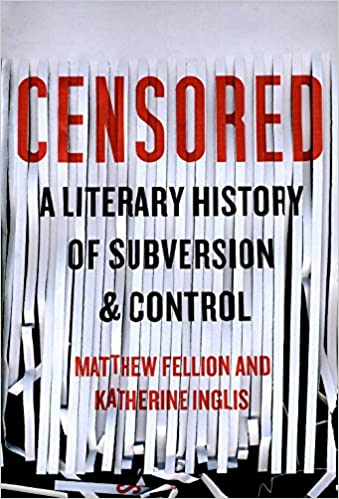Matthew Fellion and Katherine Inglis. Censored: A Literary History of Subversion and Control. Montreal: McGill-Queen’s University Press, 2017. 431p., ill. ISBN 9780773551275. US$ 34.95.
Fellion and Inglis, scholars based in Edinburgh, take on the rather large task of providing an English-language literary history of censorship beginning in the fourteenth century and ending in the twentieth. Geographically, their primary focus is the UK and the US. The authors not only cross the Atlantic, but also cross genres, including poetry, fiction, non-fiction, plays, comics, and graphic novels. The sheer quantity of topics and time periods is daunting, but Censored succeeds in its mission. With grace, astuteness, and care, the authors provide significant (but not overwhelming) details that illuminate their thesis: censorship – whether founded in political, religious, or special interest motives – is an exercise of power which inevitably hurts those with the least amount of privilege.
Beginning with the Bible in fourteenth-century England and moving forward chronologically, each chapter deals with a different example of a censored work. These include an eighteenth-century British playwright (Frances Burney), a nineteenth-century American slave narrative (The History of Mary Prince), a twentieth-century Irish novelist (Kate O’Brien), and twenty-first-century voices of the oppressed (Black Voices from Prison by Etheridge Knight and Borderlands/La Frontera: The New Mestiza by Gloria Anzaldúa). The authors move adeptly through one fascinating example at a time in order to portray all of the actors and actions involved in censorship.
At the start of the book, the authors point out that freedom of speech (and conversely the act of censorship) involves a network of participants. They define this freedom not in terms of the individual (a traditionally American view), but in terms of a community of participants – whether author, reader, publisher, seller, or importer. In this way, Censorship, though a literary history, would also appeal to scholars working in areas of book printing, publication, and trade history across many centuries and genres.
A running current through many of the chapters is the act of self-censorship. The reasons and ways both authors and publishers censor of their own accord (rather than by force of another) would be a worthwhile study in and of itself. Another related area that warrants its own study is an analysis of who is censoring and for what reasons. Are there patterns that can be seen across time periods regarding the censors and the reasons given for censoring?
The authors close with the assertion that freedom of speech in the UK and US is under threat. They warn that investigations and research in this area must continue. In particular, the authors bring our attention to censorship in the digital age as it occurs across the internet with large companies (such as Google, Amazon, Facebook) in the business (literally) of providing or denying access and thus supplying or censoring information.
Amy Hezel
Regis University


